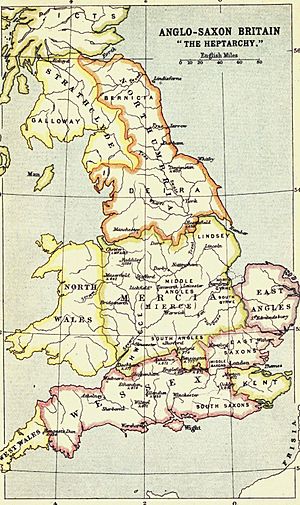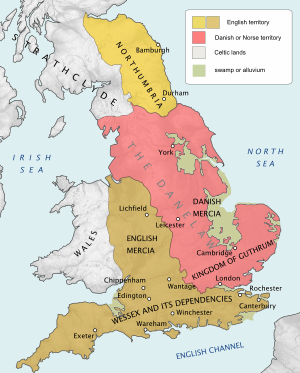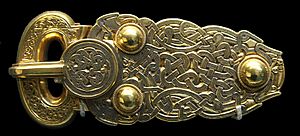Kingdom of East Anglia facts for kids
Quick facts for kids
Kingdom of the East Angles
|
|||||||||
|---|---|---|---|---|---|---|---|---|---|
| 6th century–918 | |||||||||
 |
|||||||||
| Status | Independent (6th century-869) Kingdom of the Danes (869–918) Vassal of Mercia (654–655, 794–796, 798–825) Vassal of the Danes (869–918) |
||||||||
| Common languages | Old English, British Latin | ||||||||
| Religion | Paganism (before 7th century) Christianity (after 7th century) |
||||||||
| Government | Heptarchy | ||||||||
| History | |||||||||
|
• Established
|
6th century | ||||||||
|
• Disestablished
|
918 | ||||||||
|
|||||||||
The Kingdom of East Anglia was an important early kingdom in England. It was located in what we now call Norfolk and Suffolk. This kingdom was formed by the Angles people in the 500s.
For a long time, the Wuffingas family ruled East Anglia. But in 794, a stronger kingdom called Mercia took control. Later, in 869, the Danes (also known as Vikings) conquered it. East Anglia then became part of an area called the Danelaw, which was ruled by the Danes. Finally, in 918, Edward the Elder, King of Wessex, took control. East Anglia then became part of the Kingdom of England.
Contents
History of East Anglia
The Kingdom of East Anglia started around the early 500s. Wehha is thought to be the first king, followed by Wuffa.
Until 749, the kings of East Anglia were from the Wuffingas family. This family was named after Wuffa. In the early 600s, under King Rædwald of East Anglia, East Anglia became a very powerful kingdom.
Rædwald was the first East Anglian king to become a Christian. Many experts believe he was buried in the famous ship burial at Sutton Hoo, near Woodbridge. After Rædwald died around 624, the kingdom of Mercia started to become more powerful than East Anglia.
Many of Rædwald's later successors died in battles. For example, King Sigeberht was killed. Under Sigeberht, and with help from his bishop, Felix of Burgundy, Christianity became very strong in East Anglia.
Early Settlements
Anglo-Saxons settled in East Anglia earlier than in many other parts of Britain. This might have happened as early as the 400s. The kingdom grew from groups of Angles settling in the area of the Iceni tribe. This was also where the Roman town of Venta Icenorum was, near Caistor St Edmund.
It seems that this area was not very populated around the 300s. Some historians believe that many towns and villages were empty during that time. This was not just a small change, but a real desertion of land.
According to an old writer named Bede, the East Angles came from a place called Angeln in modern-day Germany. Evidence from old objects and language shows that many Germanic people moved to this region. However, it's not clear if all of them called themselves Angles.
East Anglia was one of seven main kingdoms in early England. These kingdoms are sometimes called the Heptarchy. This idea was used by a historian named Henry of Huntingdon in the 1100s. However, some modern historians think the political situation was much more complex. They question if all seven kingdoms existed at the same time.
Pagan Rule and Early Kings
The first rulers of East Anglia were the pagan Wuffingas family. They were likely named after an early king, Wuffa. The name "Wuffingas" means "descendants of the wolf." A key source for this early history is Bede's Ecclesiastical History. However, Bede doesn't give many exact dates for the East Anglian kings.
We don't know much about the very first kings or how the kingdom was set up. But important ship burials at Snape and Sutton Hoo suggest these were centers of royal power. The "North Folk" (people of Norfolk) and "South Folk" (people of Suffolk) might have existed even before the first kings arrived.
King Rædwald was the most powerful of the Wuffingas kings. Bede called him "son of Tytil, whose father was Wuffa." For a short time in the early 600s, East Anglia was one of the strongest kingdoms in Anglo-Saxon England. Bede said Rædwald was the overlord of kingdoms south of the Humber river.
In 616, Rædwald was strong enough to defeat and kill King Æthelfrith of Northumbria. He then helped Edwin of Northumbria become king. Rædwald was probably the person honored by the rich ship burial at Sutton Hoo.
Christianity Comes to East Anglia

Christianity became established in Anglo-Saxon England during the 600s. In East Anglia, the old pagan beliefs were largely replaced. There are no East Anglian towns named after the old gods. This shows how much Christianity spread.
In 604, King Rædwald was the first East Anglian king to be baptized. However, he also kept a pagan altar. This means he still worshipped the old gods too. After 616, East Anglia was the only Anglo-Saxon kingdom with a Christian king.
When Rædwald died around 624, his son Eorpwald became king. Eorpwald became Christian because of King Edwin of Northumbria. But some people in East Anglia were against his new religion. Eorpwald was killed by a pagan named Ricberht.
After three years where paganism returned, Christianity became strong again. This happened when Eorpwald's brother (or step-brother) Sigeberht became king. Sigeberht had been baptized while he was in exile in Francia. Sigeberht helped set up the first East Anglian church. This was for Felix of Burgundy at Dommoc, probably Dunwich. Sigeberht later gave up his throne to his brother Ecgric and went to live in a monastery.
Mercian Control and Struggles
East Anglia's power, which was strong under Rædwald, began to decline. This was due to the rising power of Penda of Mercia and the kings who followed him. From the mid-600s to the early 800s, Mercia grew very powerful. A large area, including East Anglia, came under Mercian control.
In the early 640s, Penda defeated and killed both Ecgric and Sigeberht. Sigeberht was later honored as a saint. Ecgric's successor, Anna, and Anna's son Jurmin were killed in 654. This happened at the Battle of Bulcamp, near Blythburgh. After this, Penda made East Anglia part of Mercia.
In 655, Æthelhere of East Anglia joined Penda in a fight against Oswiu. This battle, called the Battle of the Winwaed, was a huge defeat for Mercia. Penda and his ally Æthelhere were both killed.
The last Wuffingas king was Ælfwald, who died in 749. During the late 600s and 700s, Mercia continued to dominate East Anglia. In 794, Offa of Mercia had the East Anglian king Æthelberht killed. Offa then took control of the kingdom for himself.
East Anglia briefly became independent again under Eadwald after Offa died in 796. But the new Mercian king, Coenwulf, quickly put down this rebellion.
East Anglian independence was restored in 825. This happened when Æthelstan led a rebellion against Mercia. Beornwulf of Mercia tried to regain control but was defeated and killed. His successor, Ludeca, also died in battle in 827. The East Angles asked Egbert of Wessex for protection from Mercia. Æthelstan then recognized Egbert as his overlord. While Wessex took over other southern kingdoms, East Anglia was able to keep its independence.
Viking Attacks and New Settlements

In 865, the Danish Great Heathen Army invaded East Anglia. They stayed for the winter and got horses before moving on to Northumbria. The Danes returned in 869 and spent the winter at Thetford. King Edmund of East Anglia attacked them, but he was defeated and killed. This battle happened at a place called Hægelisdun.
After this defeat, East Anglia was no longer an independent kingdom. The Danes put their own puppet-kings in charge. These kings ruled East Anglia for the Danes. The Danes then continued their fights against Mercia and Wessex. In 878, the last part of the Great Heathen Army was defeated by Alfred the Great. They left Wessex after making a peace treaty.
In 880, the Vikings came back to East Anglia. They were led by Guthrum. Guthrum quickly became a king and even started making his own coins. Guthrum's kingdom included the traditional area of East Anglia. It also included Cambridgeshire and parts of Bedfordshire and Hertfordshire. It probably included Essex too, which was part of Wessex that came under Danish control. Alfred and Guthrum made a peace treaty sometime in the 880s.
Becoming Part of England
In the early 900s, the East Anglian Danes faced increasing pressure from Edward, King of Wessex. In 902, Edward's cousin, Æthelwold, who had been exiled, arrived in Essex. He was accepted as king by some Danes in England. In 903, he convinced the East Anglian Danes to fight Edward. This war ended badly, with Æthelwold and Eohric of East Anglia dying in a battle.
From 911 to 919, King Edward expanded his control over southern England. He built strong forts, called burhs, in Essex and Mercia. These forts often helped control how the Danes used rivers. In 917, the Danish power in the area suddenly collapsed. They suffered many quick defeats. They lost the areas of Northampton and Huntingdon, and the rest of Essex. A Danish king, likely from East Anglia, was killed at Tempsford.
Even with help from Vikings from overseas, the Danish counter-attacks were crushed. Many of their English subjects joined Edward's army as it advanced. The Danes of East Anglia and Cambridge surrendered.
East Anglia was then absorbed into the Kingdom of England. In 1017, Norfolk and Suffolk became part of a new earldom of East Anglia. This happened when Thorkell the Tall was made earl by Cnut the Great. The church structure was also changed. Two old East Anglian bishoprics were replaced by one at North Elmham.
Old East Anglian Language
The people of East Anglia spoke Old English. Their language is very important for history. This is because they were among the first Germanic settlers to arrive in Britain in the 400s. Some experts say that East Anglia "can seriously claim to be the first place in the world where English was spoken."
We learn about different dialects in Old English by studying old texts, place-names, personal names, and coins. A. H. Smith was the first to suggest there was a separate Old East Anglian dialect. This was in addition to the known dialects of Northumbrian, Mercian, West Saxon, and Kentish. He admitted that his idea was not certain. He knew that language borders probably didn't stay the same for long.
There are no Old East Anglian manuscripts or written records that have survived. So, there is little direct proof of this dialect. However, a study from the 1930s looked at place-names in the Domesday Book. These names were often based on what local people said. This helped preserve how Anglo-Saxon places and people were spoken.
Evidence from the Domesday Book and later sources suggests a dialect boundary once existed. This line separated the English counties of Cambridgeshire, Norfolk, and Suffolk from their neighbors.
Geography of the Kingdom
The Kingdom of East Anglia was bordered by the North Sea to the north and east. The River Stour usually separated it from the East Saxons to the south. The North Sea was a busy "maritime link" to Scandinavia and northern Germany. This is according to historian Richard Hoggett.
The western border of the kingdom changed over time. It could be the rivers Ouse, Lark, and Kennett. Sometimes it stretched further west, as far as the Cam in what is now Cambridgeshire. At its largest, the kingdom included modern-day Norfolk, Suffolk, and parts of eastern Cambridgeshire.
The coastline of East Anglia changed a lot in Roman and Anglo-Saxon times. This was due to Erosion (land wearing away) and deposition (new land forming). The sea flooded the low-lying Fens. As sea levels dropped, new land formed near big river mouths. A large spit of land closed off the "Great Estuary" near Burgh Castle.
See also



